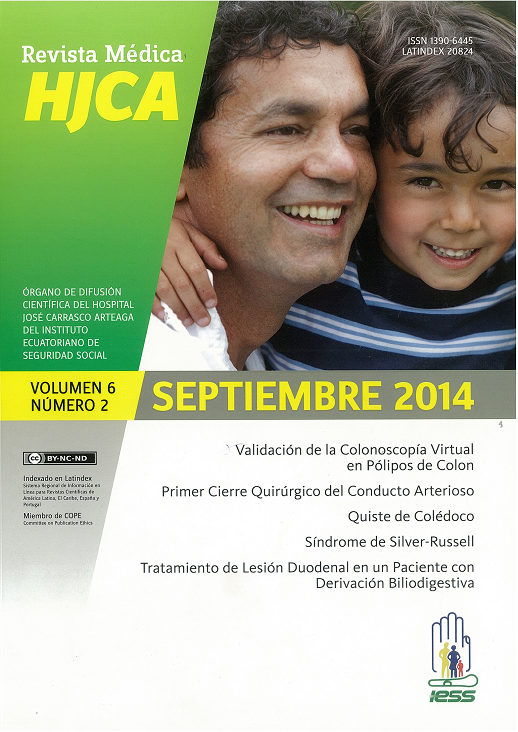Prevalencia de Pre-eclampsia en las Usuarias Embarazadas de la Clínica Humanitaria de la Fundación “Pablo Jaramillo Crespo”, desde Enero 2009 a Diciembre 2010
Palabras clave:
PREVALENCIA, PREECLAMPSIA, EMBARAZO, PREVALENCE, PREGNANCYResumen
INTRODUCCIÓN: Este trabajo tiene como finalidad establecer la prevalencia de preeclampsia, mediante un estudio descriptivo, serie de casos, de las pacientes que fueron atendidas en la Clínica Humanitaria de la Fundación “Pablo Jaramillo”, en la ciudad de Cuenca-Ecuador.
MÉTODOS: El presente estudio observacional, de prevalencia se realizó en la Clínica Humanitaria de la Fundación “Pablo Jaramillo Crespo” de Cuenca-Ecuador, en el periodo, Enero de 2009 a Diciembre 2010. Se incluyeron a las pacientes que ingresaron con embarazo mayor de 20 semanas con diagnóstico de preeclampsia (Hipertensión y Proteinuria).
RESULTADOS: De 2771 pacientes que ingresaron con un embarazo mayor de 20 semanas, 142 cumplieron con los criterios de inclusión y se excluyeron 33 pacientes por falta de datos de la madre y/o del recién nacido; en 13 pacientes no constaban en su historia clínica los exámenes de laboratorio, quedando 96 pacientes, que finalmente constituyeron la muestra. La fuente de información fueron las historias clínicas de las pacientes antes descritas, obteniéndose una tasa total de prevalencia de preeclampsia de 3.46%.
CONCLUSIÓN: La prevalencia está de acuerdo con los reportes internaciones, en el grupo estudiado.
ABSTRACT
PREVALENCE OF PRE-ECLAMPSIA IN PREGNANT USERS “PABLO JARAMILLO” HUMANITARIAN FOUNDATION FROM JANUARY 2009 TO DECEMBER 2010
BACKGROUND: This study aims to establish the prevalence of preeclampsia, including a description, number of cases, of the patients that were treated at the “Pablo Jaramillo” Humanitarian Foundation in Cuenca-Ecuador, from January 2009 to December 2010.
METHODS: This observational study of prevalence was conducted in the “Pablo Jaramillo” Humanitarian Foundation in Cuenca-Ecuador, in the period January 2009 to December 2010. It included patients admitted more than 20 weeks pregnant who were diagnosed with preeclampsia (hypertension and proteinuria).
RESULTS: Of 2.771 patients who entered more than 20 weeks pregnant, 142 met the inclusion criteria and 33 patients were excluded due to lack of data from the mother or the newborn; 13 patients did not appear on this medical history in the laboratory tests, leaving 96 patients, which eventually formed the sample. The source of information was the medical records of the patients described above, yielding an overall prevalence rate of 3.46% preeclampsia.
CONCLUSIONS: The prevalence agrees with hospitalization reports in the group studied.

